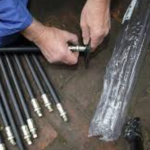Your vinyl window frames are looking great on your new replacement windows. However, you’ve managed to get them looking a bit funky. While vinyl is easy to clean and maintain, it’s not so cut and dried when it comes to cleaning off paint stains. Even though vinyl is built to be scratch-proof, you never want to risk damaging or scarring your new window replacement williamsburg model by doing a poor job of cleaning your frames. Fortunately, a paint stain isn’t forever, especially if you have the right tools and know what you’re doing. As with many cleaning jobs, time is of the essence. As long as you’re able to treat your window fairly quickly after the stain occurred, you’ll be able to counteract the damage and leave your window frame looking as good as new. Still nervous? Don’t be. If you’re trying to remove paint from your window’s vinyl frame, here’s what you should do.
Treat Different Paint Types with Different Methods

Before attempting to clean your vinyl frames, you first have to figure out what kind of paint you’re dealing with. While water-based paints can be easier to wipe away, oil-based paints are thicker and might require a bit more work, and a lot more treatment. Since the paint stain is probably a result of a separate repainting or home improvement project, nailing down the type of paint shouldn’t be too hard. If you’re not sure what kind of paint was spilled, there are other ways of finding out, namely trying a few gentler methods to see if they work. If not, you’re most likely dealing with an oil paint spill. It might take a bit more work and a few extra steps to the process, but if you use the right cleaning products you’ll be able to strip it away.
Wipe Up What You Can

If you’re looking at a fresh spill, the basic rules of cleaning apply: Wipe up everything before it sets. Luckily, since paint tends to be thicker than other liquids, you won’t have to work as fast to mop it all up before it dries. Most likely, your paint will start to drip slowly down the side, which will limit the amount of ground it covers before drying. However, be careful when you’re wiping up your paint. If you’re not extremely precise, you could end up smearing the paint over a larger area and creating an even bigger mess. The best thing is to start at the bottom of the paint drip and work your way up in a quick, thorough swipe. This way, the paint won’t be able to spread all over the place. This will most likely take a few different rags or paper towels to do, so have your stash handy. Remember, the more quickly you work, the better.
Treat with a Mild Cleaner
After you’ve removed as much of the paint as you can with a dry cloth or paper towel, you can start to assess the damage. Are there a few marks you simply can’t erase? Are you left with a streaky look? Do you have larger clumps that have dried? If the clumps are large enough, you can try removing them with a blunt-edged instrument, such as a spatula or gentle scraper. You don’t want to use anything metallic or anything too abrasive to avoid damaging the vinyl. Gently try and flake off whatever paint clumps or streaks you can. If you’re still looking at a stain, you can use a gentle soap and warm water solution to treat it. If this doesn’t work, you’ll want to switch to something a bit stronger.
Break Out the Alcohol
When your paint has started to dry, you might need something with a bit more bite to help you clean your window frame. After you’ve scrubbed the area gently with soapy water, it’s time to use some rubbing alcohol or turpentine to do the job. Letting rubbing alcohol set on the stain for at least ten minutes should help loosen it up enough to wipe cleanly off. If not, turpentine might do the trick. This will usually be enough for water-based paint stains. If you’re still left with oil paint stains, however, you’ll need to put in a bit more work, especially if you’re looking at clumps of dried, hard paint. Using either rubbing alcohol, mineral spirits, or liquid wax, use a fine steel wool sponge to scrub off the stain. While vinyl should be treated delicately, it can withstand the use of steel wool as long as it’s not overly abrasive.










